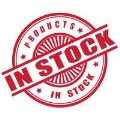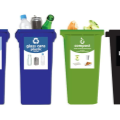

I’ll bet you never expected to read this in one of my blog posts, but here goes: Greenpeace makes some valid points in its latest comprehensive survey of the nation’s 367 material recovery facilities (MRFs). Greenpeace USA released the results of the survey last week, and they pretty much tell us what we in the plastics industry have known for a couple of decades: The number scheme for seven different types of plastics continues to be a thorn in our collective side.
As it was explained to me a few months back by an industry colleague, the numbers on the various plastics used for packaging and single-use items such as cups, drinkware, take-out food containers, and utensils, are there to identify the type of material the item is made from. The numbers do not indicate the recyclability of the items. I think a lot of consumers remain confused about that. PET #1 (water and soda bottles, etc.) and high-density polyethylene (HDPE) #2 (milk and juice jugs, etc.) are the most recyclable of the seven numbers.
Low-density polyethylene (LDPE) film, used in retail T-shirt bags, bread wrappers, paper towel wrappers, and so forth, are currently being collected through in-store recycling bins, which seems to be a pretty successful method if the full-to-overflowing bins I see in the stores where I shop are any indication. But it is still a work in process . . . and in progress.
While progress is being made in the collection and recycling of PET and HDPE and, to some extent, LDPE, it’s not good enough or fast enough for the people at Greenpeace USA. They may have a point. The survey Greenpeace conducted found that common plastic pollution items, including plastic tubs, cups, lids, plates, and trays, may not be labeled as recyclable according to Federal Trade Commission (FTC) requirements for products and labeling. Additionally, many full-body shrink sleeves that are added to PET #1 and HDPE #2 bottles and jugs make those products non-recyclable, as well.
“This survey confirms what many news reports have indicated since China restricted plastic waste imports two years ago—recycling facilities across the country are not able to sort, sell, and reprocess much of the plastic that companies produce,” said Jan Dell, independent engineer and founder of The Last Beach Cleanup, who led the survey of plastics acceptance policies at the 367 MRFs.
Those of us in the plastics industry have known that for three decades. It’s not just sorting the various types of plastics that is so insanely difficult; it’s sorting all the plastics from the paper, metals, glass (much of it broken), textiles and myriad other things (including a pet python) that get thrown into recycle bins that wreak havoc on the MRFs.
Who in their right mind thought that throwing multiple types of materials into a single container would be simple? Hiring dozens of people to stand next to fast-moving conveyor belts trying to grab the right stuff off the line so it can be relegated to the next level of the process is even crazier.
Greenpeace also takes issue with labeling. It identified numerous examples of companies such as Target, Nestlé, Danone, Walmart, Procter & Gamble, Aldi, SC Johnson, and Unilever using misleading labels. Greenpeace has asked these companies to correct their labels. Some changes are underway, said Greenpeace, but it plans to file formal FTC complaints if the change doesn’t happen.
I have to admit that I agree with Greenpeace on this issue. What is the point of saying that a plastic item is “compostable” when it is not? It may compost somewhere, in an industrial composting facility, perhaps, if you can find one that will take so-called “compostable” plastic items. Most municipalities do not have a separate bin for curbside pickup of compostables of any type, much less plastic. The same goes for biodegradable, which is why products in California cannot say “biodegradable” on them. Yes, they will biodegrade in a year or 10 years as long as they are left out in the open environment. And no, that’s not better than 1,000 years, as I once read.
So to all those brand owners who are putting “compost me” on their various plastic items, or sticking a “biodegradable” label on a product, which means it’s okay if it’s left on the beach or along the roadside because it will soon go away, please stop! What you’re doing is “greenwashing.” You’re making things worse, not better!
The Greenpeace survey revealed that many MRFs only accept two types of post-consumer plastic items—PET #1 and HDPE #2 bottles and jugs—because the items have sufficient market demand and domestic processing capacity. Maybe that’s all they should accept. If the #3 to #7 plastic items cannot be labeled as recyclable because they have “low acceptance by MRFs, minimal to negative material value, and negligible processing capacity in the U.S.,” then perhaps we need to question why we’re even throwing these items into the recycling stream in the first place.
Some plastic items—not just those for recycling but for composting and biodegradability, as well—say to check locally on the instruction label. So the average consumer is supposed to get online, look for the nearest composting facility, call them and ask about the compostability of a plastic item, or call the MRF and ask which types of plastics they sort out for recycling and which go to the landfill? If we have #3 to #7 going to the landfill or incinerator, then why are we even putting these items in the blue bins? (I’m actually not opposed to incinerating #3 to #7 plastic along with other burnable waste, and have encouraged it in many of my blogs.)
“Retailers and consumer goods companies across the country are frequently putting labels on their products that mislead the public and harm America’s recycling systems,” said Greenpeace USA Oceans Campaign Director John Hocevar. “Instead of getting serious about moving away from single-use plastic, corporations are hiding behind the pretense that their throwaway packaging is recyclable. We know that this is untrue. The jig is up.”




















.jpg)

.jpg)



.jpg)



.PNG)








